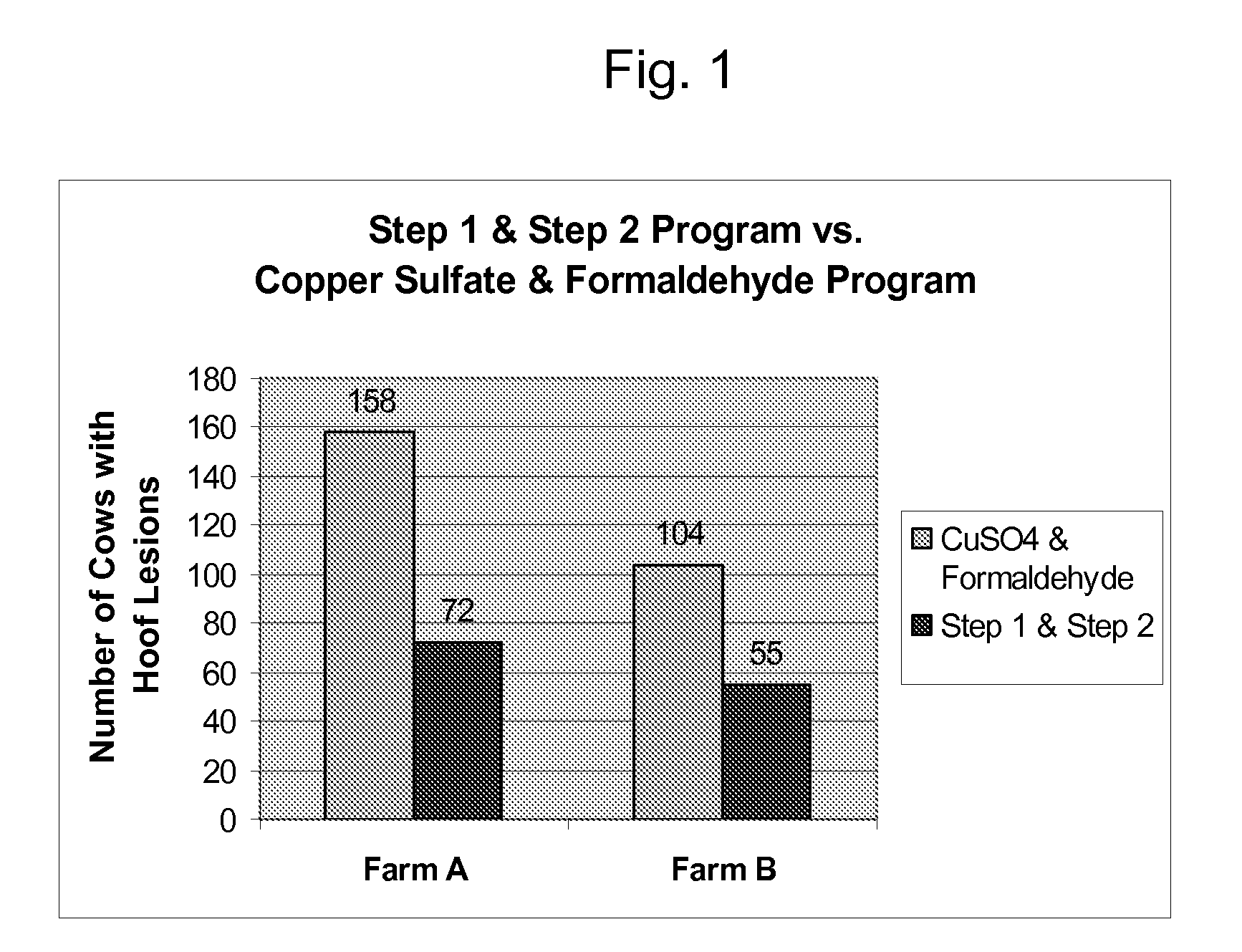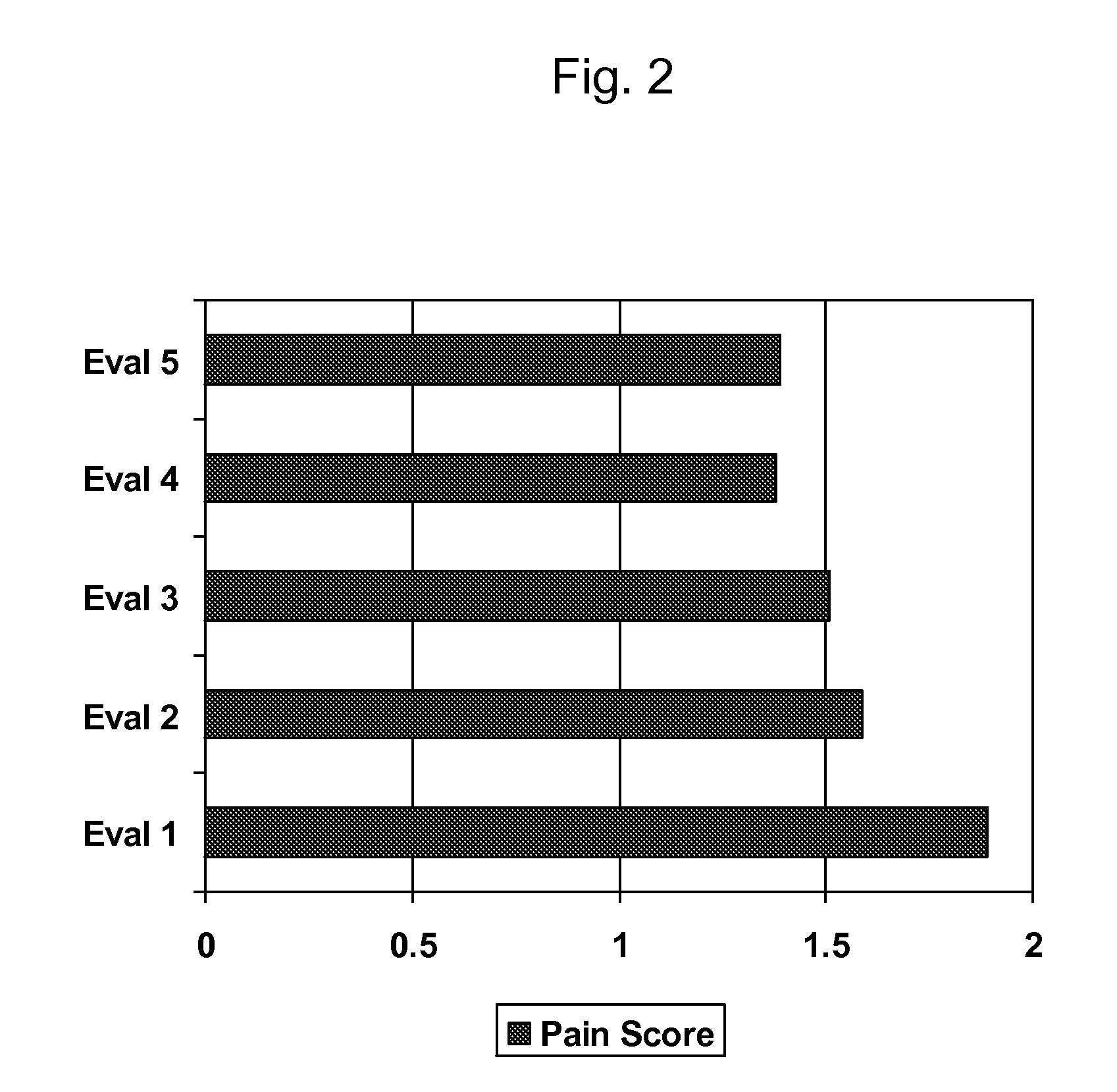Compositions and methods for treatment of diseases of the foot of an animal
- Summary
- Abstract
- Description
- Claims
- Application Information
AI Technical Summary
Benefits of technology
Problems solved by technology
Method used
Image
Examples
example 1
Footbath Studies
[0098]The following example compares compositions of the present invention to conventional describes use of rotational footbath programs with Tasker SaniPhresh™ Step 1 and Tasker SaniPhresh™ Step 2 in combination with reduced amounts of copper sulfate as a replacement for rotational footbath programs using copper sulfate and formaldehyde at controlling hoof lesions on large dairy herds. The objective of the trials was to compare the effectiveness of the Tasker SaniPhresh™ Step 1 and Tasker SaniPhresh™ Step 2 Rotational Footbath Program with a copper sulfate and formaldehyde rotational program at controlling hoof lesions (Hairy Heel Warts and Foot Rot) on two large commercial dairy herds.
[0099]A footbath program using footbath solutions made up with copper sulfate crystals in rotation with milking shifts using footbath solutions made up with formaldehyde is historically considered an effective hoof care program. In this example, a Tasker SaniPhresh™ Step 1 and Step 2 ...
example 2
Footbath Studies
[0107]The following example demonstrates the influence of Tasker SaniPhresh™ Step 1 and 2 Rotational Footbath Program on the incidence of heel warts (Papillomatosis Digital Dermatitis, PDD) in commercial dairy herds from two farms, C and D.
[0108]The commercial dairy farm C had 550 cows, which were milked three times daily. Prior to the study, farm C had been unsuccessful in controlling heel warts with prior footbath protocols. Over 20% of the herd from farm C was diagnosed as having heel warts prior to the study. Heel wart-related pain is positively associated with lameness, involuntary culling, reduced food and water intake, reduced milk production, and reduced profits. The study was conducted over 8 weeks, with 5 evaluations conducted at 2 week intervals along with weekly monitoring.
[0109]Results from farm C showed that the Tasker SaniPhresh™ Step 1 and Step 2 foot bath program significantly reduced the severity of PDD (heel wart) pain regardless of pen over the 8 ...
example 3
Disinfection Composition Effect on Listeria Monocytogenes
[0115]The effect of an acidic buffered copper containing disinfection composition was examined on Listeria monocytogenes. The disinfection agent was commercially available Tasker Pacific Blue (including sulfuric acid, ammonium sulfate, copper sulfate, and water).
[0116]Twelve tubes of nutrient broth were inoculated with 10 ul of culture (L. mono., Scott A strain, log phase growth at 108 cfu / ml) to contain 105 cfu / ml Listeria monocytogenes. 1 ml of peptone buffer is added to the control samples (6). 1 ml of Tasker 10× solution (pH 2.8, 3 ppm copper) to treated samples (6). Tubes stored at 40° F. for 4 days and then analyzed for Listeria monocytogenes.
[0117]Results showed that controls had 3,000,000 cfu / ml at Day 1 and 21,000,000 cfu / ml at Day 7. Treated groups had 200 cfu / ml at Day 1 and <10 cfu / ml at Day 7 (see e.g., FIG. 15; Table 8).
TABLE 8Tasker Blue effect on L. Mono contentAfter 24 hours, plated on Palcam Agar:40° F.cont...
PUM
 Login to View More
Login to View More Abstract
Description
Claims
Application Information
 Login to View More
Login to View More - R&D
- Intellectual Property
- Life Sciences
- Materials
- Tech Scout
- Unparalleled Data Quality
- Higher Quality Content
- 60% Fewer Hallucinations
Browse by: Latest US Patents, China's latest patents, Technical Efficacy Thesaurus, Application Domain, Technology Topic, Popular Technical Reports.
© 2025 PatSnap. All rights reserved.Legal|Privacy policy|Modern Slavery Act Transparency Statement|Sitemap|About US| Contact US: help@patsnap.com



